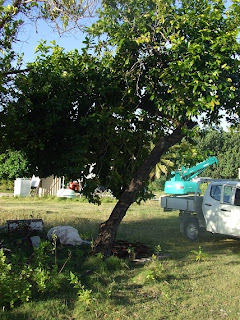I landed on this speck of land in the Indian Ocean (2900km's NW of Perth) to look at gardens and native vegetation. An unlikely place to look at gardens i must admit. An unlikely place to start a vegetable garden one might say, but isolation from Australia also isolates the residents of this island from readily available inexpensive fresh food. Many perishable food items need to be flown in and this understandably adds significantly to their price.
So grow your own. Sounds easy - you are on a tropical island! However I'm lead to believe that all is not what it seems.
The other farming relict that are all around are the old Coconut plantations that cover the islands and were once the livelihood of 2000 people are now overgrown with Scaevola taccida (Cabbage bush) and Morinda citrifolia (Rotten cheese fruit or Noni in the pacific). Boats would come from Home island to harvest the coconuts on the other islands. These would then be processed for export but the industry was regarded as unviable years ago. Millions of coconuts now drop to the ground here each year with only a handful harvested by locals.
Rows of limes are still evident while there are individuals of other fruit trees scattered here and there.
So grow your own. Sounds easy - you are on a tropical island! However I'm lead to believe that all is not what it seems.
My learning curve began with a quick tour of the old orchard and farm. On the way to the farm i am introduced to the wild chickens which seem to be doing quite well with no predators other than rats to bother them. They make peace with the land crabs and they both share the mown verges of the roads before retreating to the impenetrable coconut forests beyond when they are disturbed.
At the orchard there is an old hydroponics setup where a food farming venture started up once upon a time - and died an untimely death. There are many stories about how and why it failed but i think the consensus was that it failed due to human foibles rather than an inability to grow food. They grew food and they grew lots of it, both in the ground and through hydroponics.
Rows of limes are still evident while there are individuals of other fruit trees scattered here and there.
 |
| Black Sapote |
These scattered trees and shrubs include Mango, Fig, Carambola (Star fruit) and Breadfruit. Black Sapote (chocolate pudding fruit) and Curry leaf. There were a lot more there in the past including Custard apple, Soursop but many have died or been salvaged by locals. Some fruit species that were tried but were thought not to be successful due to pollination difficulties were Jack fruit, Avocado, Mangosteen. One untried species was Cashew, which should enjoy this climate. Maybe someone knows if it has been tried somewhere on the islands?
Mangoes are a popular fruit that people would like to grow but they were badly affected by disease on the farm and only a few fruiting trees exist on all of the islands. There are some theories that they do not successful flower due to the lack of variability in the seasons or because of the presence of a fresh-water lens. I the Darwin area growers of Mangoes induce them to flower earlier by cutting off their water supply (stressing them) so there presence of a permanent freshwater lens would mean that the trees are never stressed due to lack of water. There are one or two trees known to fruit well (at least sometimes) on home island. It is possible that this could be grafted on other root stocks as it may be a variety that is genetically more suited to this climate. Generally the Mango needs a lot of TLC and if root stocks that were resistant to diseases could be obtained, this may add to the chances of successfully growing Mangoes.
Mangoes are a popular fruit that people would like to grow but they were badly affected by disease on the farm and only a few fruiting trees exist on all of the islands. There are some theories that they do not successful flower due to the lack of variability in the seasons or because of the presence of a fresh-water lens. I the Darwin area growers of Mangoes induce them to flower earlier by cutting off their water supply (stressing them) so there presence of a permanent freshwater lens would mean that the trees are never stressed due to lack of water. There are one or two trees known to fruit well (at least sometimes) on home island. It is possible that this could be grafted on other root stocks as it may be a variety that is genetically more suited to this climate. Generally the Mango needs a lot of TLC and if root stocks that were resistant to diseases could be obtained, this may add to the chances of successfully growing Mangoes.





No comments:
Post a Comment